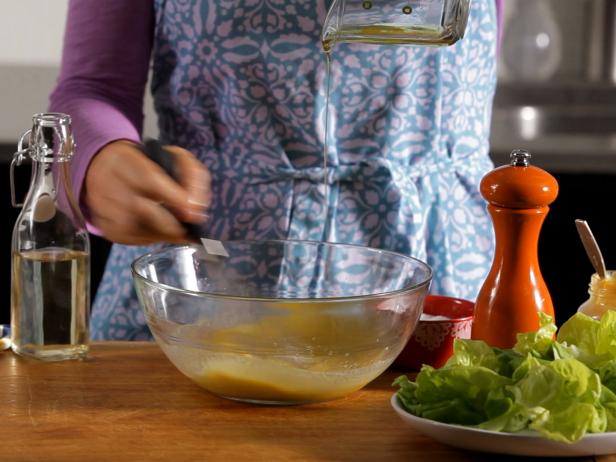Sure, you could choose from the hundreds of bottles available at any grocery store—or, you could remember a bit of salad-dressing arithmetic and know how to make vinaigrette anytime, anywhere, and with ingredients you probably already have on hand. Bonus: Itll taste better, and youll probably spend less money in the long run.
The formula starts with the most basic vinaigrette pairing: plain old oil and vinegar. Once youve mastered combining those two ingredients, add in another, and then another, eventually working your way up to our ultimate seven-ingredient version. One-by-one, each new ingredient will add dimensions of flavor and texture until your dressing is so good, youll wonder why you ever went bottled in the first place.
Go as basic or as complex as you want—just remember this: building your own dressing is as easy as 2, 3, 4, 5, 6, 7.

2 Ingredients: The basics
To make a bare-bones vinaigrette, all you need is vinegar (sherry, Champagne, balsamic, cider, red, white, or rice wine vinegar all work) and oil (go with a neutral vegetable oil like grapeseed for a mild base, or your best extra-virgin olive oil for grassier undertones). Traditional vinaigrette recipes call for a ratio of three parts oil to one part vinegar. However, some people—like me—prefer their dressings to pack more punch and choose a 2:1 oil-to-vinegar ratio. Some vinegars have a higher level of acidity than others, so its always a good idea to sample your dressing and adjust accordingly.
To make your vinaigrette, whisk a little kosher or fine sea salt into some vinegar until it dissolves. Start with about ¼ teaspoon salt per tablespoon of vinegar. Keep whisking and slowly drizzle in double the amount of oil as vinegar, then taste. I like to dip a lettuce leaf into the dressing to see how it will taste in my salad instead of tasting it on its own.
If desired, gradually add more oil, tasting incrementally, until you achieve a balance of acidity and fat you enjoy. This two-ingredient dressing will never fully emulsify, but a vigorous whisking will hold it together long enough to dress your salad (just shake or whisk again before serving if you make extra to enjoy throughout the week). Finish the dressing off with some freshly ground black pepper.
A note on citrus: lemon, lime, orange, or grapefruit juices lend a lovely brightness when subbed in for a portion of the vinegar in a vinaigrette. But, like the name indicates, this dressing has to include vinegar to be considered a true vinaigrette.
5 Ingredients: Add an allium
Alliums like garlic and shallots play very well with oil and vinegar. Work wonders by integrating a clove of chopped or grated garlic or a spoonful of finely chopped shallot into your dressing blend. If the taste of raw garlic is too intense for you, try poaching a peeled clove in simmering water for three minutes to remove some of its bite. To tame the oniony flavor of shallot, soak it in the vinegar for at least five and up to 15 minutes before adding the rest of the ingredients to your dressing.
Basic Vinaigrette 3:1 RATIO
FAQ
What is the component of vinaigrette?
What is a vinaigrette made of?
Is vinaigrette 3 parts oil and 1 part acid?
Which vinaigrette contains acid?
All vinaigrettes contain acid. Whether it be citrus juice or vinegar (vinaig-rette, vinegar, get it??), acid is an element that is absolutely essential. For a simple vinaigrette, we like red wine vinegar, white wine vinegar, or sherry vinegar, which offer plenty of tang and flavor without being too overwhelming.
How do you make a good vinaigrette?
The French have decided that the perfect ratio for a vinaigrette is 3 parts oil to 1 part vinegar. For my personal taste, that’s a little too oily — but it’s totally up to you. My simple system is: In a small screw-top jar, place vinegar and a pinch of salt; cover and shake (this helps to dissolve the salt). Then, add olive oil, and shake again.
What is a good vinaigrette?
For a simple vinaigrette, we like red wine vinegar, white wine vinegar, or sherry vinegar, which offer plenty of tang and flavor without being too overwhelming. It’s good to keep the ratio of vinegar to oil (which we’ll get to later) in mind.
What is vinegar and olive oil based vinaigrette?
Vinegar and olive oil-based vinaigrette is a light, zippy, heart-healthy salad dressing. It’s great on greens, vegetables and fruits. You can change up the flavor by using different vinegars. Vinaigrette is easy to adjust to taste, and I’ve included notes how to do so in the recipe. Once you start making homemade vinaigrette, you won’t go back.
